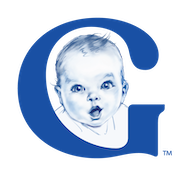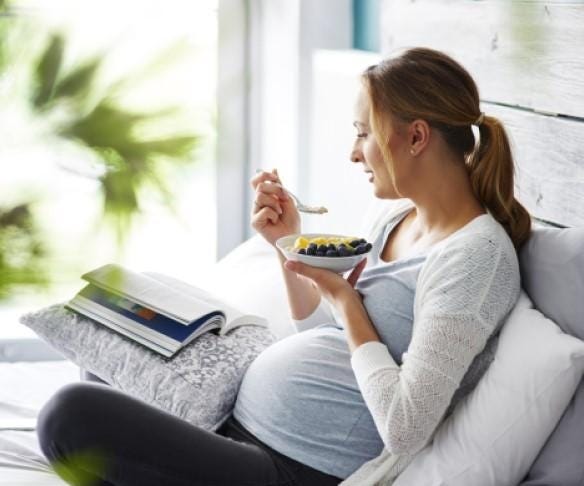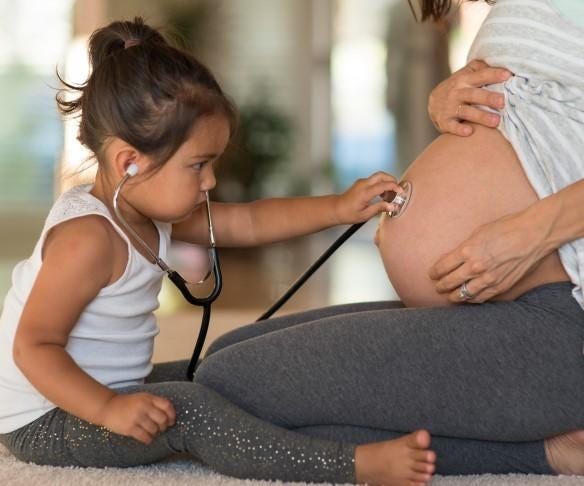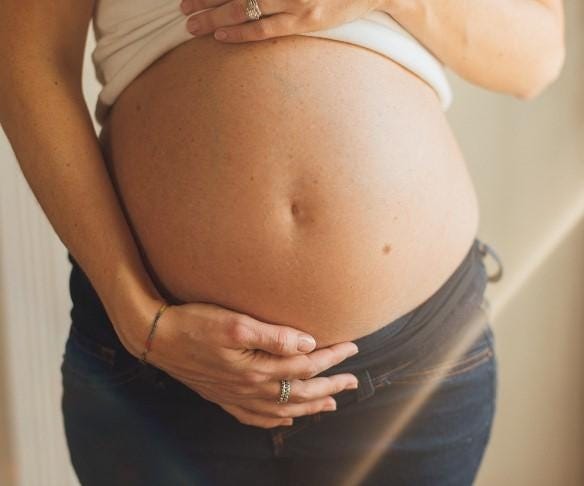
WEEK 10
Wow! Your Baby's Almost A Fetus
How baby grows
It’s official! This week marks your baby's last week as an embryo; as your baby’s brain growth speeds up and neural cells continue to multiply. The rest of thier body’s growing too; they're now about the size of a small plum and weighs about half an ounce.
Next week they'll officially become a fetus.
And there's still a lot of other activity keeping baby busy:
- Teeth. Tooth buds for baby teeth will begin forming inside the mouth.
- Reproductive organs and external genitals. They will be formed, although it will still be too early to determine gender.
- Nervous system. This will continue to develop.
- Internal organs. Many of the internal organs will begin to function.
- Intestines. They have been developing inside the umbilical cord and have begun moving into the abdominal cavity.
- Taste buds. They will begin to appear on the surface of the tiny tongue.
- Upper lip. This will form completely.
- Joints. Most of the joints will form, including elbows, wrists, knees, shoulders and ankles.
How You Change
- You're still in regular clothes. Despite your baby's growth spurt, you can probably still wear your regular clothes. Very little of your total pregnancy weight gain—usually between 25 and 35 pounds—will happen during the first three months.
- Fatigue and nausea. You may still feel tired and a little sick, but it may help to know that in a few weeks, you'll probably be feeling a lot better!
WEEK 11
Baby’s Officially A Fetus…and has Fingernails!
How Baby Grows
By the end of this week your little fetus will be about two inches from head to bottom and still weigh about half an ounce—but they'll double in size and weight over the next three weeks, and their major organs are now fully developed.
Other changes you can expect this week:
- Fingernails will begin to appear.
- Ears. Your baby's ears will move toward their final position on the sides of her head.
- Genitalia. Your baby's external genitalia are beginning to develop, and in a few weeks an ultrasound exam may tell you whether you're having a boy or girl.
- Action! Your baby will begin to swallow and kick.
- Bones. They will begin to slowly solidify, although most of the skeleton is still made of flexible material.
- Brain. Nerve cells in the brain are busy connecting with each other, building pathways for future communication.
- Spinal nerves. They will begin to stretch out from the spinal cord.
- Heartbeat. With a special handheld device, your doctor will be able to hear the fetus' rapid heartbeat.
How You Change
- Uterus expansion. As you get near the end of the first trimester, your uterus continues to expand, almost filling your pelvis as it supports your growing baby.
- Waist growth. Your waist keeps growing, but it’s probably not time for maternity clothes yet.
- Skin changes. Changes in your hormones can lead to an increase in your skin's production of melanin, and a dark vertical line of pigmentation on your abdomen, called the linea nigra, might appear. This line is a common sign of pregnancy and will fade after pregnancy. The fairer-skinned you are, the less noticeable this line will be, during and after pregnancy.
- Hair and nail changes. Hormones also affect hair and nails. Many women find that their nails grow faster and their hair stops shedding. As a result your hair will seem thicker and fuller than ever before.
Be Careful
There’s nothing wrong with looking good, but watch out for hair dyes and perms. Even though there’s no proof that dyes or perming chemicals can harm your growing baby, it's still a good idea to wait until after the birth.
WEEK 12
That Beautiful Face!
How Baby Grows
By now, your baby has a profile, complete with a little chin and a tiny nose. Inside the mouth, folded tissues have join to form the palate, or roof of the mouth, which separates the oral and nasal cavities.
Your baby’s almost doubled in size in the past few weeks, to almost 3 inches long!
Some other fascinating things will happen this week:
- Kidneys. Amniotic fluid will build up as your baby's kidneys begin to produce and excrete urine into the fluid.
- Pancreas. It will begin to produce insulin, a hormone that regulates blood sugar levels.
- Liver. It will start to secrete bile, a thick, greenish fluid stored in the gall bladder that helps the body digest fats.
- Digestive process. The muscles in the intestinal walls will begin to practice contractions. Basically your baby is practicing the digestive processes that will begin after birth.
- Brain. The brain's basic structure is intact by the end of this week, and brain mass is growing all the time.
- Pituitary gland. It will begin to produce hormones.
- Hair. Soft, non-pigmented hair—believed to protect your baby's skin before birth—will begin to appear on your little one's body. Most of this hair, called lanugo, will disappear soon after birth.
How You Change
- Uterus enlargement. Sometime during this week your uterus will probably move upward and forward as it continues to enlarge. This means less pressure on your bladder for a while. Eventually, however, your uterus will get large enough so that it will push against the bladder again, increasing your need to urinate.
- Skin radiance. During this week, as more blood flows through your blood vessels and hormones increase oil gland secretion, you may experience flushed, plumper, smoother skin.
- Skin problems. Hormone-related oil activity may have other effects on your skin, such as temporary acne or brown patches called chloasma on the face or neck. Not to worry: Most of these skin problems are only temporary, and disappear after birth.
- Nausea and fatigue goes away. Many women now start to feel better in the pregnancy as fatigue and nausea fade away.
- Weight gain. Because of hormonal changes, you may notice that you're gaining weight in your hips, legs and sides.
WEEK 13
Getting Ready to Make Some Noise
How Baby Grows
Even though it's still pretty early in your pregnancy, your baby can already do a lot. If you poke your stomach gently with your finger, your baby may begin to turn their head toward you. Some experts think this may be the beginning of the rooting reflex (looking for a nipple).
By now your baby can put a thumb into their mouth, although their sucking muscles aren't completely developed.
Girl babies will have already accumulated about 2 million eggs in their ovaries, although this number will drop to 1 million at birth.
Her head growth has slowed down; this week it makes up about half her body length. By week 21 her head will be about a third the size of her body, and by birth it will only be about a fourth.
Now about 3 inches long and weighing little more than an ounce, your baby would fit snugly into your cupped hands, but your baby’s got lots more growing to do before you’ll have a chance to hold them.
Here's what else to look forward to this week:
- Tiny ribs will develop.
- Vocal cords will begin to form.
- Eyelids will fuse together to protect her delicate eyes.
- Tissues and organs will continue to mature.
- Bone marrow, liver and spleen will be able to produce blood cells now.
- Fingerprints begin to form.
How You Change
- Increased comfort. As the second trimester approaches, most women begin to feel much more comfortable than they did in earlier stages of pregnancy. The side effects of early pregnancy (frequent urination, fatigue, nausea, dizziness) generally lessen during the second trimester.
- Abdominal achiness. At 13 weeks the uterus starts growing upward into the abdomen, and you may feel some abdominal aches as the ligaments supporting the uterus stretch.
- Weight gain. As your baby starts growing rapidly, you'll see your weight increase.
- Colostrum production. Even though birth is still months away, your breasts may already have started to make colostrum, the nutrient-rich fluid that will feed your baby for the first few days after birth.
- Breast changes. As the breasts enlarge, you may notice veins appearing under the skin and the areola enlarging and turning brown. Experts think this darker color around the nipple may be a visual cue for the breastfeeding baby.
- Stretch marks. You may start to see the first signs of stretch marks on your abdomen, breasts, hips or buttocks. Since stretch marks are partly genetic, you may be able to predict ahead of time whether you'll experience them or not.
Good to Know
Lotions may help calm the itchiness that sometimes goes with stretch marks. Lotions may also help reduce the marks, but it’s hard to completely prevent them. The good news is that they’ll be less noticeable after pregnancy, when they'll probably fade to a more normal skin color.






